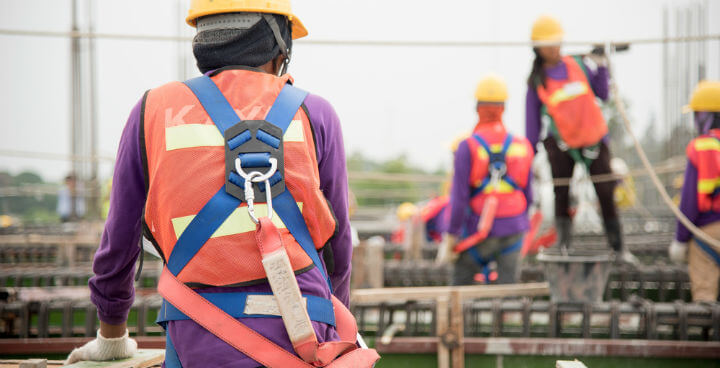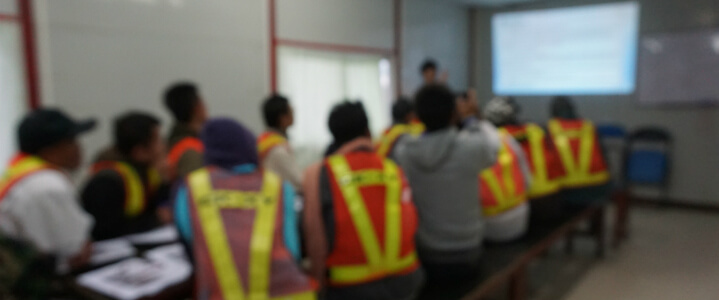Fall protection safety is an important consideration for businesses everywhere. When your employees work up high, you want to ensure that they do so with proper care and caution. With that in mind, we look at some of the top safety tips for working at heights.
Hazards Associated with Working at Heights
When working from heights, falling is the most obvious safety hazard. But even a dropped tool or piece of equipment can cause severe injury or even death. A fall from a sufficient drop will render that tool unusable, costing the company money in unnecessary repairs.
If workers lack confidence when working from ladders or other equipment, it can lead to sloppy, rushed work. However, with proper working-at-heights training, your workers can gain the confidence to stay on task.
The Census of Fatal Occupational Injuries (CFOI) has reported that in 2018, there were nearly 900 deaths due to fatal falls. In fact, falls are among the OSHA fatal four when it comes to workplace fatalities.
The following workers/industries have the highest fatal falls overall:
- Roofers
- Electrical power-line installers and repairers
- Structural iron and steelworkers
How High Is Working at Height?
Working at height is working in or around an area where falling is a risk. OSHA guidelines dictate that this is any workspace four feet or higher in general industry settings. Select industries have different working at height standards.

Some prominent examples would be working on a roof or a raised platform, but working at height also includes working on ladders and even some tall stepladders. When employees work at height, safety should be a priority.
Is Working at Heights a Safety Hazard?
OSHA defines a hazard as follows:
“A hazard is the potential for harm. In practical terms, a hazard often is associated with a condition or activity that, if left uncontrolled, can result in an injury or illness.”
There is obvious potential for workers to be harmed while working at height. Height-related incidents are one of the most prominent causes of workplace injuries. In addition, falling from height can be a uniquely fatal accident.
Managers should prioritize fall protection safety and try to mitigate the risks that employees are subject to. Contact Safety By Design for help from our safety risk management consultants.
What Is a Height Work Permit?
A Height Work Permit is a document that helps to administratively control the safety of workers as they work at height. The permit should include a working at height checklist. This checklist can consist of PPE inspection, OSHA fall protection training, and acknowledgment of regulations.
Each worker should complete the items on the checklist before being allowed to work at height.
When Is Fall Protection Safety Equipment Required?
Osha requires fall protection at different levels. Four feet is the minimum height at which precautions should be taken. It changes depending on the industry:
- Four feet for general industry work
- Five feet for shipyards
- Six feet for construction job-sites
- Eight feet for longshoring operations
Do My Employees Need Working at Heights Safety Training?
The short answer to this question is yes. Many employees are unaware of the dangers they are working around. The familiarity with the workspace and tasks can hinder their awareness and lead to accidents.
Employers should proactively inform workers exactly how to do their jobs in the safest way possible. This includes training in how to adequately use and test safety equipment.
Benefits of Sharing Fall Safety Tips in the Workplace
Fall protection safety is everyone’s responsibility, which is why it’s crucial to share fall protection safety tips with your workforce. Doing so will prevent accidents and make your workers feel more confident when working at heights.
Emphasizing these fall safety topics can also protect your equipment. Dropped tools can impact your construction budget and slow your project’s progress. But sharing these fall safety tips for the workplace equips your employees to watch out for each other and their equipment effectively.

Top 10 Working at Heights Safety Precautions
Below are six important fall and safety precautions. It is not an exhaustive list, but many workplaces can benefit from these best practice guidelines for working at height. You’ll notice that this list includes different levels of the hierarchy of hazard control.
For more thorough help, you can connect with the safety consultants at Safety by Design.
1. Perform a Job Safety Analysis
Job safety analysis simply means that you’ll break down the entire job (or the entire construction site) into individual tasks. Don’t be afraid to be too detailed.
Once you catalog the individual tasks, highlight any areas of concern. For instance, if a job requires a lot of work to be performed at height, you might be particularly concerned about providing working from heights training for your workforce.
2. Identify Potential Hazards
Every worker should be on the lookout for potential hazards in their work area. One of the ways to improve job safety is to teach your personnel to identify potential risks, so you can take measures to eliminate minor problems before they become larger issues.
3. Enforce All Safety Rules
Managers should enforce all safety precautions while working at height and should also resist the temptation to ease off on enforcing them as time goes on. Familiarity does not make the dangers go away, and discipline in enforcing the rules is best for everyone in the end.
4. Provide Proper (And Inspected) PPE
Managers should provide PPE when the situation requires it. However, it isn’t enough to provide fall protection safety equipment. Workers should be trained in how to use it and how to inspect it continually.
Eye and face protection is only useful when it functions properly, so employers should do everything within their power to ensure it will. Inspections should be thorough and frequent. An excellent way to establish this is to include inspection in your company’s Height Work Permit, discussed above.
5. Accurately Calculate Fall Distances
It may seem silly to mention this, but this important detail can be easily miscalculated. It is intuitive to assume that a fifteen-foot harness would be adequate for a twenty-foot fall.
This, however, would fail to calculate the worker’s height and any slack the harness or anchor point would have from the force of the fall.
A worker who was six feet tall would have hit the ground while wearing his useless harness. A fall protection plan for working at height is pointless if fall distances are miscalculated.
6. Add Guard Rails When Possible
Guard rails are an excellent option for protecting employees working at height. This precaution allows workers to be passively safe. They may even be safe working at height without a harness.
It can be helpful to avoid adding steps to their work process like managing and inspecting extra equipment. Instead, workers can simply stay within the railing.
Workers will have to set up those guard rails, so make sure those workers have been trained and given proper PPE for the task.
7. Use Ladders Correctly
Ladders can be a significant safety hazard when misused. When using a ladder, always remember three things:
- Extend the ladder 3 feet past the level to which you’re climbing
- For every four feet that the ladder rises, place it one foot from the structure
- Maintain three points of contact (e.g., one hand, two feet) at all times
Given the hazards associated with working at height, OSHA ladder safety training might be among your priorities when offering workplace safety tips and training.
8. Determine Proper Anchor Points
The anchor points to which safety harnesses are attached must be adequately stable to hold if a fall occurs. The force of a fall is significant. Therefore, the anchor points should be something solid like a structured beam, or it should be determined by an engineer.
9. Regularly Inspect Equipment
Perform regular inspections to ensure that your equipment is working correctly. This inspection is especially important for equipment that raises workers to a height, such as ladders, cherry pickers, or other machinery.
10. Keep Up with Training
Employees should provide continual working at heights safety training, especially as new workers join the project or the workspace changes. This may be official, like a training session or something as casual as daily reminders on the job.

Safety By Design Offers Reliable Working at Heights Training
Do all these fall protection safety tips seem a bit daunting? Is it difficult to imagine where you’ll find the time to manage it all? You can start with our working at height course – a section of our Houston safety training program. This course will teach you about safety while working at height and so much more. We have spent years building our knowledge and expertise in the field of safety.
Contact us to start building a safer workspace!
Tags: fall protection, safety training, workplace safety


